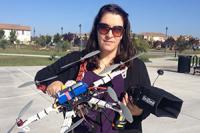-
Search in Illinois, Indiana for missing canister holding radioactive materials
Teams from the Illinois Emergency Management Agency (IEMA) are continuing their search in Illinois and neighboring Indiana for a missing steel canister containing radioactive material. The locked steel canister was last believed to be in a custom oil well logging truck. The nuclear material was used by an Illinois company specializing in surveying oil wells.
-
-
$100 million NIAID contract to SRI International to develop radiation exposure treatment

SRI International has been awarded a resource contract of up to $100 million over five years by the National Institute of Allergy and Infectious Diseases (NIAID), part of the National Institutes of Health, for the development of products to mitigate or treat acute or delayed effects of radiation exposure.
-
-
Amendment to CISA: U.S. courts could pursue foreigners for crimes abroad against other foreigners
A controversial amendment to an already-controversial cybersecurity bill will allow U.S. courts to pursue, convict, and jail foreign nationals in cases in which these foreigners committed crimes against other foreigners on foreign soil. The amendment to the Cybersecurity Information Sharing Act (CISA) cleared a key Senate hurdle on Thursday. It aims to lower the barrier for prosecuting crimes committed abroad.
-
-
EFF leads privacy advocates in opposing CISA
Privacy advocates have intensified their campaign against the Cybersecurity Information Sharing Act (CISA), which the Senate will vote on sometime next week. The Electronic Frontier Foundation (EFF) says it vehemently opposes the bill, as well as amendments which would expand the Computer Fraud and Abuse Act. EFF says that CISA is fundamentally flawed. The bill’s broad immunity clauses, vague definitions, and what EFF describes as “aggressive spying powers” combine to “make the bill a surveillance bill in disguise.”
-
-
Ruling shows Europe still vexed over NSA spying, leaving U.S. companies in legal limbo
For over fifteen years, the Data Transfer Pact between the European Union and the United States, more commonly known as Safe Harbor, had ensured that companies with EU operations could transfer online data about their employees and customers back to the United States despite stark differences between U.S. and European privacy law. Earlier this month, U.S. companies operating in Europe got some unwelcome news: Safe Harbor had been ruled invalid. The European court’s ruling has serious implications for these companies’ business models and profitability, leaving many scrambling to find solutions. But it also exposes a fundamental cultural rift between the U.S. and Europe’s conceptions of privacy – one that a new agreement won’t be able to paper over.
-
-
New tool allows users to see how their personal information is used on the Web
Navigating the Web gets easier by the day as corporate monitoring of our e-mails and browsing habits fine-tune the algorithms that serve us personalized ads and recommendations. But convenience comes at a cost. In the wrong hands, our personal information can be used against us, to discriminate on housing and health insurance, and overcharge on goods and services, among other risks. “The Web is like the Wild West,” says one researcher. “There’s no oversight of how our data are being collected, exchanged and used.”
-
-
Climate change will reshape global economy: Study
Unmitigated climate change is likely to reduce the income of an average person on Earth by roughly 23 percent in 2100, according to estimates contained in a new study. The findings indicate climate change will widen global inequality, perhaps dramatically, because warming is good for cold countries, which tend to be richer, and more harmful for hot countries, which tend to be poorer. In the researchers’ benchmark estimate, climate change will reduce average income in the poorest 40 percent of countries by 75 percent in 2100, while the richest 20 percent may experience slight gains.
-
-
If you think your emails are private, think again
When you type up a racy e-mail to a loved one, do you consider the details private? It appears that at least some Internet users expect a different, and higher, level of privacy simply because the information is cloaked in an e-mail. That’s the issue at stake in a pending lawsuit against Yahoo! Inc. Plaintiffs filed an e-mail privacy lawsuit against Yahoo in the U.S. District Court for the Northern District of California under several privacy laws, including the Stored Communications Act (SCA) — a federal law that prohibits an e-mail service provider from knowingly divulging to any person or entity the contents of a communication while in electronic storage. The plaintiffs won a short-term victory in achieving class action certification, but the bigger issue over whether they can object to the scanning of their e-mails by Yahoo — based on a right to privacy — given Yahoo’s disclosure of its scanning and possible sharing practices and given that they chose to send and/or receive an e-mail to a Yahoo user, is far from being decided in their favor.
-
-
Will the Supreme Court kill the smart grid?
On 30 April, Tesla’s Elon Musk took the stage in California to introduce the company’s Powerwall battery energy storage system, which he hopes will revolutionize the dormant market for household and utility-scale batteries. A few days later, the Supreme Court announced that it would hear a case during its fall term that could very well determine whether Tesla’s technology gamble succeeds or fails. At issue is an obscure federal policy known in the dry language of the electricity business as “Order 745,” which a lower court vacated last year. Order 745 allowed electricity customers to be paid for reducing electricity usage from the grid — a practice known as “demand response.” It also stipulated that demand response customers would be paid the market price for not using the grid — like the power industry’s version of paying farmers not to grow corn. This case, ultimately, is far more significant than getting paid for not using electricity. It’s about who gets to set the rules of the road for emerging technology in the electricity sector — the states or the federal government — and whether the United States will be able to modernize its energy policy the same way that it would like to modernize its power grid.
-
-
Lockheed Martin begins production of modular high-power laser

Lockheed Martin has begun production of a new generation of modular high power lasers this month. The first laser built using the modular technique will be a 60-kilowatt system for a U.S. Army vehicle. The Army has the option to add more modules and increase power from 60kW to 120kW. Laser weapons provide a complement to traditional kinetic weapons in the battlefield. In the future, they will offer reliable protection against threats such as swarms of drones or large numbers of rockets and mortars.
-
-
Court allows ads for “The Muslims are coming!' on New York subway
A federal judge las week allowed the posting of light-hearted subway advertisements promoting a documentary about American Muslim comedians, ruling that a transportation agency improperly labeled them political in nature. Judge Colleen McMahon said the advertisements created by two Muslim comedians – one including the line: “The Ugly Truth about Muslims: Muslims have great frittata recipes” — were not primarily political. “That the advertisements at issue gently mock prejudice and employ Islamophobia as a comedic device does not make their message ‘prominently or predominantly’ political,” she wrote.
-
-
Tackling the under-representation of British Muslims in top professions
A new report finds that British Muslims are least likely to hold professional or managerial jobs of any religious group in Britain — at only half the average level (16 to 30 percent) — and that more likely to be unemployed or living in poverty. The report calls for urgent action from government, employers, universities, and within the Muslim community to encourage economic participation and prevent conscious or unconscious discrimination.
-
-
Two new projects tackle e-mail security
In the early, halcyon days of the Internet, researchers were more interested in sharing information rather than securing it. Now, decades later, securing the world’s most widely used medium for business communication is a full-time job for researchers and IT specialists around the globe. The modern working world cannot exist without e-mail, but hackers exploit this vital service to steal money and valuable information. The National Institute of Standards and Technology (NIST) is tackling this threat with two new projects.
-
-
FAA proposes $1.9 million civil penalty for unmanned drone operations

The Federal Aviation Administration (FAA) the other day announced the largest civil penalty the FAA has proposed against a drone operator for endangering the safety of U.S. airspace. The FAA proposes a $1.9 million civil penalty against SkyPan International, Inc. of Chicago. The FAA says that SkyPan conducted sixty-five unauthorized operations in some of the U.S. most congested airspace and heavily populated cities, violating airspace regulations and various operating rules.
-
-
European Court of Justice: U.S. data systems expose users to state surveillance
The European Court of Justice (ECJ) in Luxembourg has ruled that U.S. digital data storage systems fail to provide sufficient privacy from state surveillance. The ECJ declared the American so-called safe harbor scheme “invalid.” The ruling, which is binding on all EU members states, stated that: “The United States … scheme thus enables interference, by United States public authorities, with the fundamental rights of persons…” The ruling will have far-reaching ramifications for the online industry and would likely lead many companies to relocate their operations.
-
More headlines
The long view
Need for National Information Clearinghouse for Cybercrime Data, Categorization of Cybercrimes: Report
There is an acute need for the U.S. to address its lack of overall governance and coordination of cybercrime statistics. A new report recommends that relevant federal agencies create or designate a national information clearinghouse to draw information from multiple sources of cybercrime data and establish connections to assist in criminal investigations.
Trying to “Bring Back” Manufacturing Jobs Is a Fool’s Errand
Advocates of recent populist policies like to focus on the supposed demise of manufacturing that occurred after the 1970s, but that focus is misleading. The populists’ bleak economic narrative ignores the truth that the service sector has always been a major driver of America’s success, for decades, even more so than manufacturing. Trying to “bring back” manufacturing jobs, through harmful tariffs or other industrial policies, is destined to end badly for Americans. It makes about as much sense as trying to “bring back” all those farm jobs we had before the 1870s.
The Potential Impact of Seabed Mining on Critical Mineral Supply Chains and Global Geopolitics
The potential emergence of a seabed mining industry has important ramifications for the diversification of critical mineral supply chains, revenues for developing nations with substantial terrestrial mining sectors, and global geopolitics.
Are We Ready for a ‘DeepSeek for Bioweapons’?
Anthropic’s Claude 4 is a warning sign: AI that can help build bioweapons is coming, and could be widely available soon. Steven Adler writes that we need to be prepared for the consequences: “like a freely downloadable ‘DeepSeek for bioweapons,’ available across the internet, loadable to the computer of any amateur scientist who wishes to cause mass harm. With Anthropic’s Claude Opus 4 having finally triggered this level of safety risk, the clock is now ticking.”
